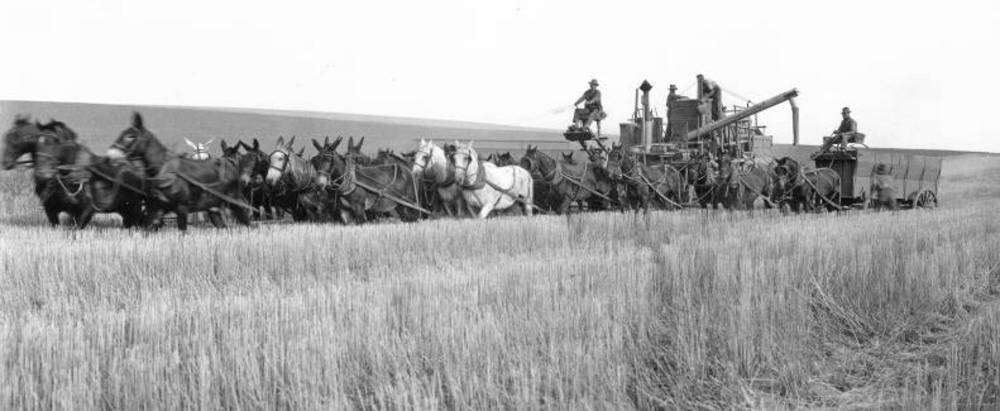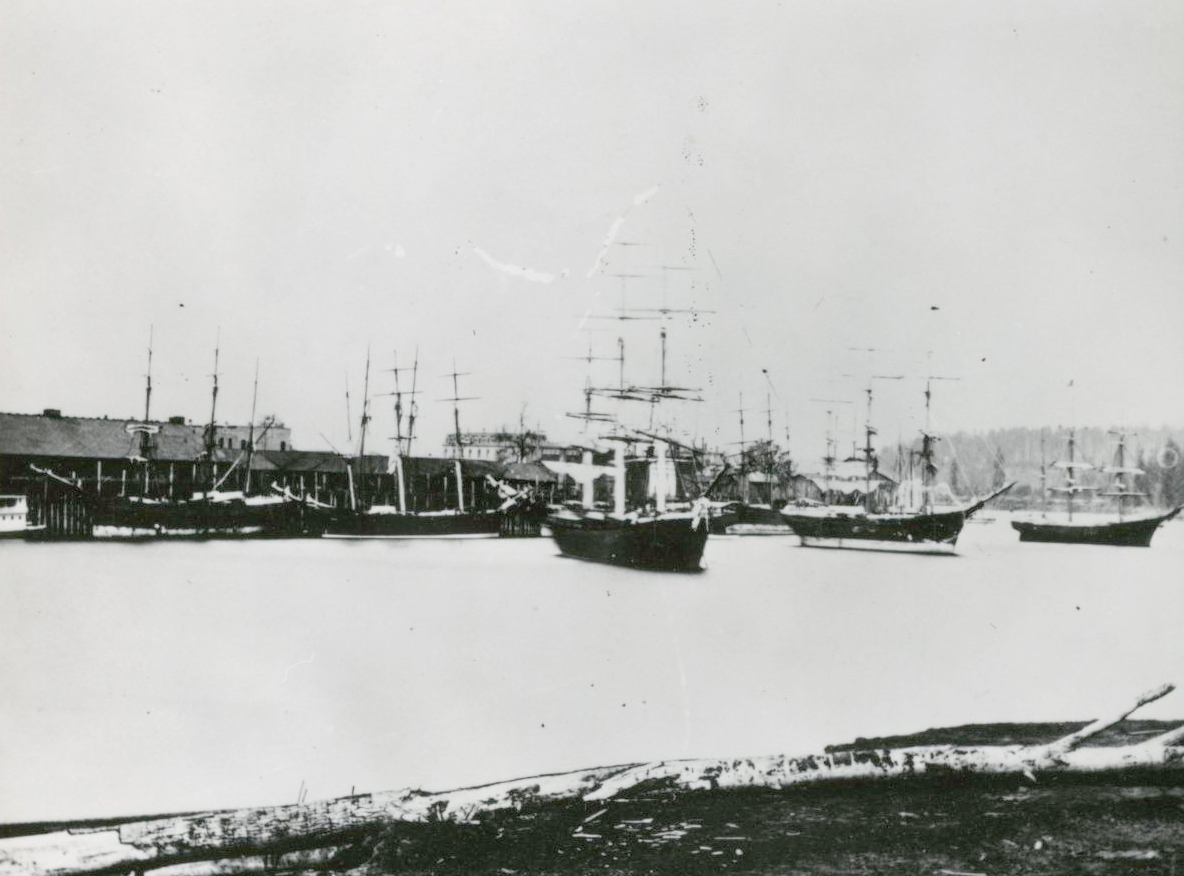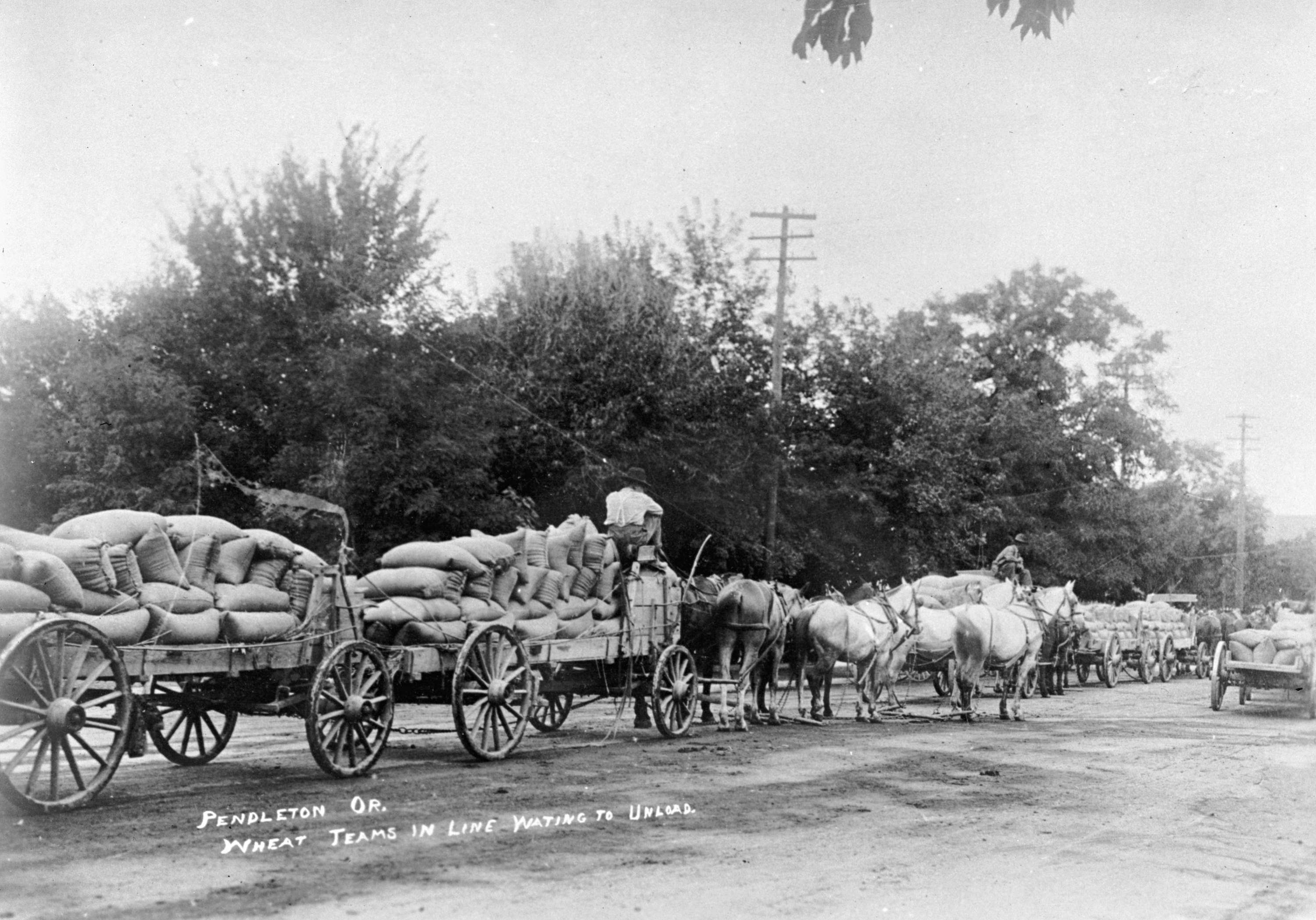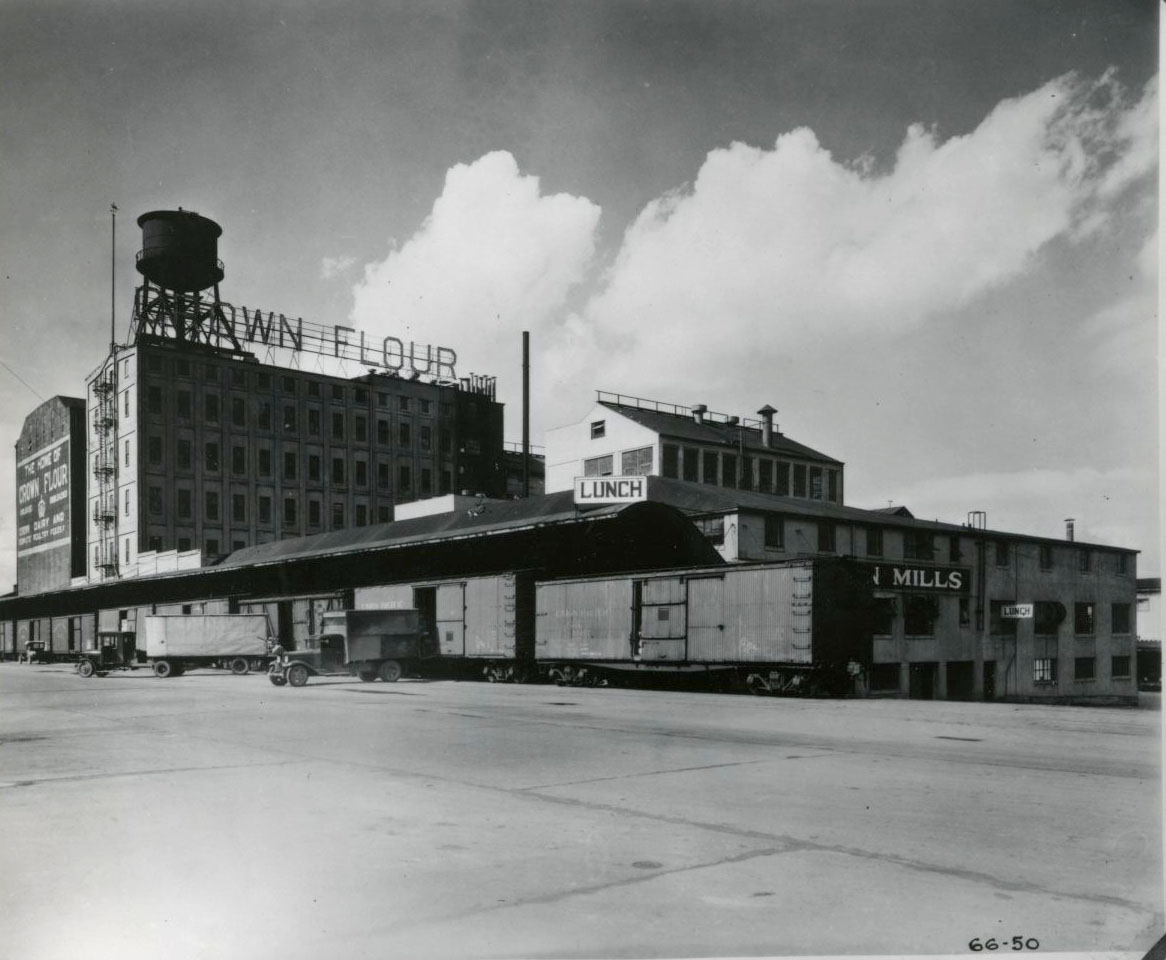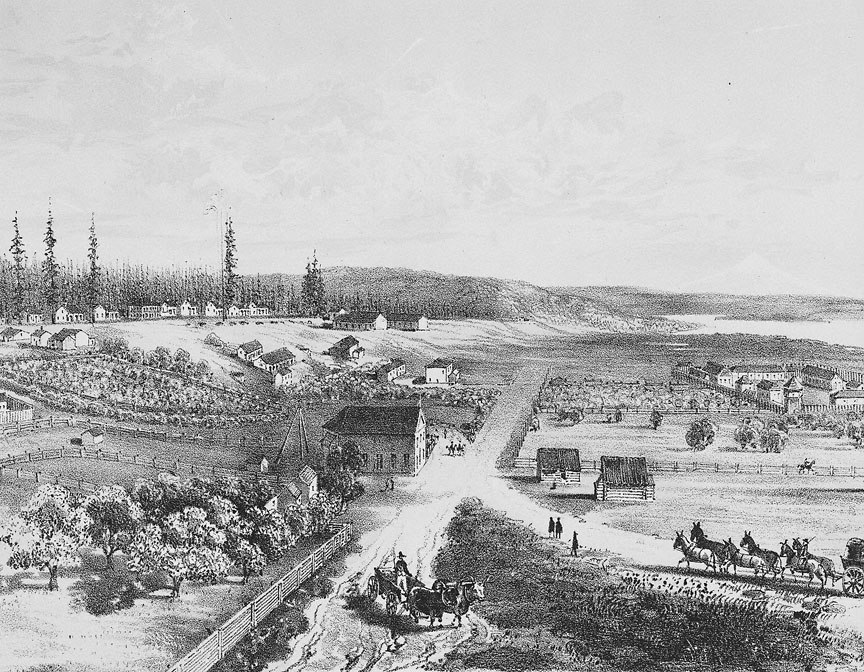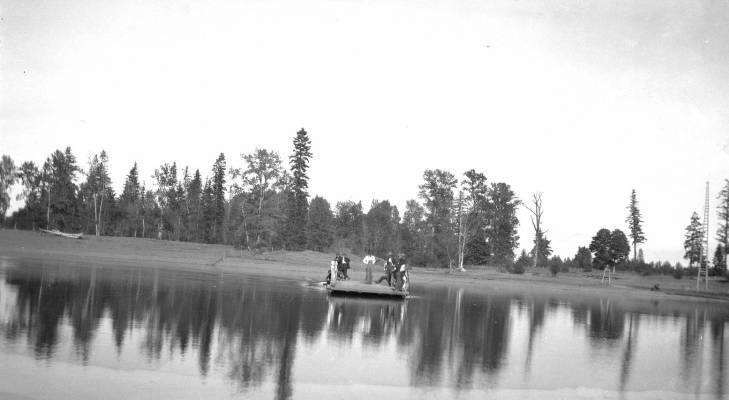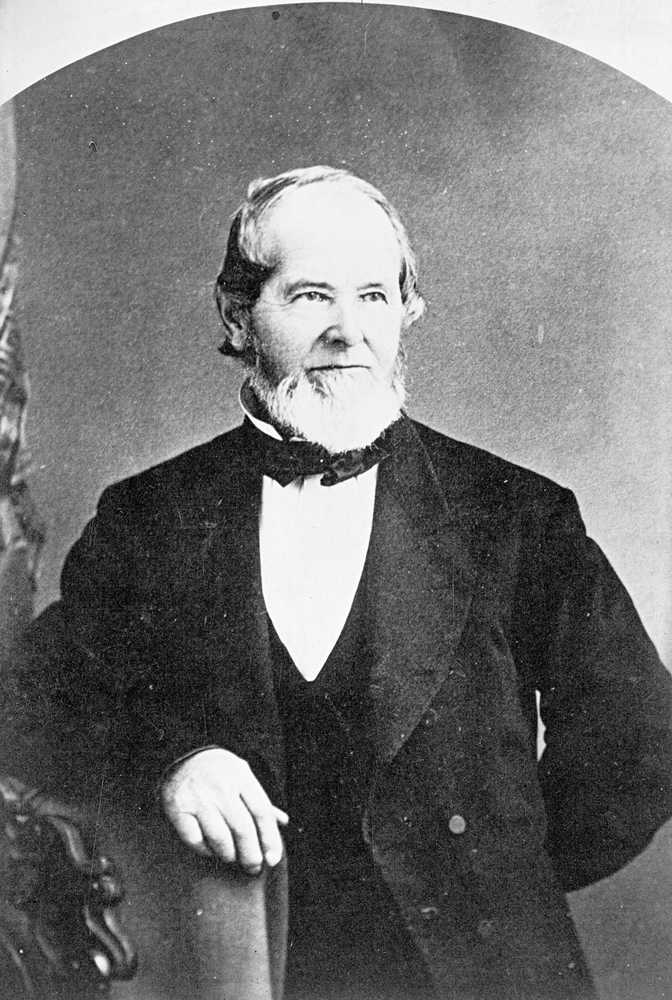In the United States, wheat is consistently among the top five crops in terms of acreage and farm-gate value (corn and soybeans typically vie for the top two spots). While wheat is consistently among the top ten crops grown in Oregon, the acreage given to the grain is relatively small, and the state typically ranks in the eleventh-to-fifteenth range in U.S. production. Oregon has exported wheat since non-Natives resettled the Oregon Country in the mid-nineteenth century. In the twenty-first century, more than 80 percent of the wheat grown in Oregon each year is exported, most of it low-protein soft white wheat, which is used primarily for noodles, pastries, and flatbreads.
The Hudson’s Bay Company introduced wheat to the Oregon Country in the early nineteenth century to feed its employees. By 1830, HBC had grown sufficient wheat on company farms to discontinue its reliance on shipments of flour from England. A few years later, in 1839, the company entered into a contract with the Russian-America Company to send wheat to Russian posts in Alaska as payment for trapping rights there. An HBC agronomist (crop expert) tested grains and legumes for their suitability in the region.
Wheat seed was an essential item for emigrants headed to Oregon, and HBC provided their former employees and other white resettlers in the Willamette Valley with seeds and the tools they needed to grow crops. The resettlers made wheat their prime commercial crop, and as early as 1841 a member of the U.S. Exploring Expedition observed that “the land as far as I could see on both sides” of the Willamette River was “cultivated with wheat.” By the mid-1840s, Oregon farmers were helping HBC honor its contract with the Russians, and wheat had become an unofficial currency as people exchanged bushels of their harvest for HBC trade goods. In effect, what HBC accepted as exchange value in wheat established the grain’s market price.
Throughout the territorial period and after statehood, wheat was a mainstay in the Oregon economy. When the territorial government borrowed money to finance the Cayuse War in 1849–1850, for example, officials established a wheat loan commission to provide collateral for the public debt. The California Gold Rush in 1849 and the southern Oregon gold strikes in 1851 became a strong market for Willamette Valley wheat farmers.
By the post-Civil War years, Oregon’s wheat was valued on the international market, a change that made it a prime export for the state and made Portland an important international wheat port, a role it continued into the twenty-first century. During the late 1800s and early 1900s, a so-called grain or wheat fleet of fifty to a hundred vessels appeared each year in the port of Portland to load sacked wheat for shipping to distant parts of the world. Railway networks in both western and eastern Oregon hauled wheat and other goods to the port for export, and farmers in the Rogue Valley grew wheat to sell to miners and traders headed to California.
Most areas of the state had regional, water-powered mills to provide flour for local consumption. In the mid-1900s, nearly all of the mills closed down and were demolished. Mills operating in Oregon in the twenty-first century include Ardent Mills, a national grain miller, with facilities in Tualatin, Arlington, and Klamath Falls, and a number of smaller-scale, specialty product mills, including Bob’s Red Mill in Milwaukie, Butte Creek in Eagle Point, and Camas Country Mill in Eugene. A few early flour mills remain as historic sites, including the Thompson's Mill (c. 1864) in Shedd.
Varieties of Wheat and Plant Breeding
Wheat varieties came from a number of sources during the early years of non-Native settlement in Oregon. In the 1850s, the Hudson’s Bay Company introduced Big Club, a southern European yellow spring wheat, and white settlers brought Ukrainian hard red spring bread wheats such as Red Fife. They also brought Goldcoin (later known as Fortyfold), a soft white spring wheat grown in the eastern United States. These varieties were spring wheats, but some had enough winter-hardiness to survive cold weather. Fall planting resulted in higher yields and spread the seasonal workload, though spring varieties that did not survive the winter had to be replanted. Turkey Red, a true winter wheat from Crimea, was introduced to Oregon in the late nineteenth century and was a dominant variety for decades.
After the mid-nineteenth century, regional plant-breeding programs were established in Oregon farm country through the work done at new land-grant colleges. Plant breeding—that is, improving plants by making crosses among parents and selecting the best offspring—became a mainstay of study by land grant universities across major crops, including wheat, corn, soybeans, barley, and potatoes. In Oregon, wheat-breeding began in about 1910, with a focus on developing winter-hardy and shorter statured plants that do not lodge—that is, permanently fall flat to the ground—at maturity.
By the late twentieth century, plant geneticist Warren Kronstad, an internationally recognized wheat breeder at Oregon State University, had collaborated with colleagues at other universities to revolutionize the art and science of wheat-breeding. He became part of what was called the Green Revolution—plant breeders who introduced lodging-resistant, fertilizer-response wheat and rice varieties that revolutionized food production. (Some would say the changes were not always beneficial, and the practices of plant breeding and genetic modification are studied for plant diversity and the health of ecosystems and consumers.)
While private plant-breeding companies have market dominance in other areas of the United States, public varieties are still commonly used in Oregon because regional commodity commissions have strongly supported wheat-breeding. Organized under the Oregon Department of Agriculture, commodity commissions are driven and led by growers. They self-tax the producers of a commodity and use the proceeds to fund marketing and research. During the late twentieth and into the twenty-first centuries, the Oregon Wheat Commission has provided approximately a million dollars each year for wheat research. Those funds have given wheat growers a strong voice in OSU research programs and have held private, non-member companies somewhat in check in comparison to other agricultural areas.
Organizations
For knowledge about farm programs, a voice in program development, international market intelligence, marketing opportunities, and the latest production practices, Oregon wheat growers rely on the Oregon Wheat Growers League (OWGL), the Oregon Wheat Commission (OWC), wheat research programs at Oregon State University and its agricultural experiment stations, and the federal Farm Program. The OWGL, the OWC, and most early experiment stations were organized at the request of wheat growers in eastern Oregon; they now serve the entire state.
Oregon Wheat Growers League
The Oregon Wheat Growers League was formed in February 1926 after more than two hundred growers, grain handlers, grain millers, and marketers gathered in Moro, in north-central Oregon, to discuss their 1925 crop year. Much of the winter wheat crop had died during the winter of 1924, and there was an unprecedented need for spring wheat seed. The research and extension faculty at Oregon Agricultural College (now Oregon State University) worked with growers to secure the seed needed to “save” the 1925 growing season. That effort led to conversations about research, seed sourcing, marketing, and grain transportation and a recognition of the power of collaboration. The result was the Eastern Oregon Wheat League, established in 1926, the first wheat commodity organization in the U.S.; the name was changed to Oregon Wheat Growers League in 1948.
Oregon Wheat Commission
Oregon growers experienced low wheat prices during the Great Depression, when the large acreages of the grain needed during World War I had led to surpluses after the war. To prevent a surplus from developing after World War II, the Oregon Wheat Growers League decided in mid-1945 to increase the demand for wheat through promoting exports and developing additional uses of wheat. There was also a growing need to address other industry problems, including high freight rates. The OWGL sent representatives to Salem to persuade the Oregon legislature to authorize wheat growers to raise money by taxing themselves for each barrel of wheat they produced. The Oregon legislature agreed, and Governor Earl Snell appointed the first Oregon Wheat Commission in 1947 to administer the money accrued from the assessment. It was among the first commodity commissions in the United States funded by a tax on producers.
Commodity commissions in Oregon—there were twenty-two in 2024—are statutorily authorized, special-purpose state agencies with limited oversight by the Oregon Department of Agriculture. All other facets of their operations are funded and managed by a local producer group. The OWC originally had five wheat growers who represented Oregon growing regions. It was subsequently expanded to include a wheat handler, a wheat exporter, and a member of the public. All commissioners are appointed by the director of the Oregon Department of Agriculture. In 2021–2022, the assessment was budgeted at $2.1 million, with 56 percent going to wheat research, 15 percent to market development (mainly through U.S. Wheat Associates and the Wheat Marketing Center in Portland), and 30 percent to the OWGL.
Agricultural Experiment Stations
Because each farm has its own microclimate and soil type, experience is usually a farmer’s best resource in making decisions. But when a new wheat variety or chemical is released or a new disease affects a crop, farmers rely on Oregon State University Agricultural Experiment Stations, first established at Union in 1901. The Columbia Basin Stations in Moro (Sherman Station,1909) and Pendleton (1927) include a focus on wheat. Wheat-breeding began at OSU in the early 1900s and since then Experiment Stations have conduct trials of hundreds of wheat varieties and promising chemicals to control diseases and weeds. Farmers attend annual field days to view the trials and interact with OSU researchers and other experts. In the early 2000s, private companies began developing varieties in the Pacific Northwest, often in cooperation with public programs. Dozens of public and private varieties with desirable characteristics are now available.
Laws and Regulations
Overproduction of agricultural commodities, including wheat, depressed prices during the 1920s, the result of increased harvests to satisfy demand during World War I. Oregon Senator Charles L. McNary and Iowa Senator Gilbert N. Haugen wrote agricultural relief bills focused on limiting production. Congress passed the needed legislation four times between 1924 and 1931, but presidential vetoes killed them all. Nonetheless, the McNary-Haugen remedies for low prices for agricultural commodities became the core of New Deal legislation during the 1930s.
When wheat prices crashed at the beginning of the Great Depression, Congress responded with the first comprehensive federal farm program in the country, the Agriculture Adjustment Act of 1933. The purpose of that bill, and all commodity-support farm programs until 1996, was to reduce supply and raise prices by restricting the acres farmers could plant to certain crops. The bill also included a “price support” that effectively required the government to buy crops, such as wheat, if the price drops below a specified minimum (known as the loan rate). The original Agriculture Adjustment Act was declared unconstitutional by the U.S. Supreme Court in 1936, and Congress passed a revised version in 1938 that put more emphasis on soil and water conservation.
As the U.S. exported more and more of its wheat crop, however, it became clear that trying to increase prices by limiting U.S. production was not working. In the 1980s, half of the U.S. wheat crop was being exported and sold on the world market, and limiting wheat production had little effect on those prices. In 1996, Congress passed the Federal Agriculture Improvement and Reform Act of 1996, known as the Freedom to Farm Act, with strong support from crop-producing state legislators, including those in Oregon. The bill removed the link between income support payments and farm prices by turning subsidies into fixed payments. Farmers were still limited to planting prescribed acres of fruits and vegetables government contracts; but instead of leaving fields fallow, they could plant crops, such as wheat and rice. Within limits, growers had the freedom to farm as they saw fit. The bill also increased federal subsidies for crop insurance. Many eastern Oregon farmers have benefited from these federal farm programs, but fewer western Oregon growers have participated, primarily because many crops grown in western Oregon were not covered by such programs.
As farms have consolidated and increased in size, giving large cash payments to individual growers and family operations became increasingly difficult to justify. In response, the Oregon Wheat Growers League and growers of other large-acreage, commodity crops shifted their focus, calling for improvements in the federal crop insurance program. Wheat farmers are now offered payments for adopting practices that limit soil erosion and promote wildlife habitat. The Food Security Act of 1985 included the Conservation Reserve Program and most notably conservation compliance requirements: to be eligible for commodity subsidies, farmers had to comply with provisions known as swampbuster (addressing the draining of wetlands) and sodbuster (addressing the plowing of native sod), and required conservation planning for farming on highly erodible land.
The Effect of Climate on Wheat Production
Much of the Pacific Northwest has a Mediterranean climate, with wet, mild winters and dry summers that are not exceptionally hot. Climate Change is affecting those historic trends. Winter wheats survive well under temperate conditions and typically produce a higher yield than spring wheats do. In eastern Oregon, given the dry summers and the significant range in rainfall—that is, fewer than ten inches in the rain shadow east of the Cascades to about fourteen inches farther east—growers discovered that it was most reliable to use a summer fallow system of production, planting a crop every other year and using the fallow year to store water in the ground.
During the early twentieth century, clean summer fallow became the dominant production system in eastern Oregon—that is, following inversion-plowing (burying all crop residue) with additional mechanical tillage, a practice that resulted in significant soil degradation. With experience, increased scientific knowledge, and a better understanding of the effects of clean summer fallow systems, many growers are working toward improving soil health (it may have other long-term ecological consequences).
Scientists predict that a warming Earth will result in the global decline of wheat yields—higher temperatures increase evaporation, reduce kernel count and quality, and make insect infestations more likely. Seasons (in length and temperature) and precipitation amounts are no longer as predictable as they once were. In an effort to predict and plan for the effects of rising temperatures, agriculturists in Oregon have identified agronomic zones, which are categories of landscapes that share similar characteristics, including soil depth, number of growing days, and rainfall. Scientists are able to make generalizations about crop management and seed selection within the zones to help farmers adjust to changing conditions and benefit from innovations.
-
![]()
Combine harvester in Culver, c. 1910.
Oregon Historical Soc. Research Lib., Org. Lot 78, box 5, folder 7, 043 -
![]()
Wheat harvesting in Oregon.
Courtesy Oregon State University -
![Combine drawn by 26 head of mules and horses in a field of Federation wheat on the W.N. Myrick ranch, Athena, July 1925.]()
Hay harvest, Athena.
Combine drawn by 26 head of mules and horses in a field of Federation wheat on the W.N. Myrick ranch, Athena, July 1925. Oreg. State Univ. Archives, Extension and Experiment Station Communications coll., Umatilla Basin series, P120:01125
-
![]()
-
![]()
"Wheat Fleet" on the Willamette, 1899.
Courtesy Oregon Hist. Soc. Research Lib., 008725
-
![]()
Wheat fields near Woodburn, 1911.
Oregon Historical Society Research Library, 018890.
-
![Wheat teams in Pendleton, about 1938.]()
Pendleton, wheat teams at, OrHi 12553.
Wheat teams in Pendleton, about 1938. Oreg. Hist. Soc. Research Lib., OrHi 12553
-
![]()
Harvesting wheat, Silverton area, c.1908.
Oregon Historical Soc. Research Lib., June D. Drake photographs, 1863-2001, Org. Lot 678, Box 42, 1316 -
![]()
Harvesting wheat, Culver, Oregon, c. 1910.
Oregon Historical Soc. Research Lib., Org. Lot 78; Box 5, Folder 7; 051 -
![]()
Wheat field, Prineville, c. 1911.
Oregon Historical Soc. Research Lib., Spokane, Portland, and Seattle Railway photographs; Org. Lot 78; Box 5, Folder 7; 008 -
![]()
Wheat Field in Central Oregon, c. 1915.
Oregon Historical Soc. Research Lib., Spokane, Portland, and Seattle Railway photographs; Org. Lot 78; Box 5, Folder 7; 018 -
![]()
-
![]()
-
![]()
Wheat field in Albany, Oregon.
Courtesy Oregon Hist. Soc. Research Lib., 018899
Related Entries
-
![Albers Brothers Milling Company]()
Albers Brothers Milling Company
Bernard (or Bernhard) Albers emigrated from Lingen, Germany, to Indiana…
-
![Crown/Centennial Mills]()
Crown/Centennial Mills
For eighty years, Crown Mills, known as Centennial Mills after 1949, wa…
-
![Hudson's Bay Company]()
Hudson's Bay Company
Although a late arrival to the Oregon Country fur trade, for nearly two…
-
![Lincoln (town)]()
Lincoln (town)
After about 1850, wheat was the most important crop in the Willamette V…
-
![Moro]()
Moro
The town of Moro, the county seat of Sherman County, is located about e…
-
![Oregon Producers’ Exporting and Importing Company]()
Oregon Producers’ Exporting and Importing Company
In the early months of 1847, a group of Willamette Valley farmers organ…
-
![Wasco]()
Wasco
Wheat farming, ranching, and wind turbines drive the economy of the sma…
Related Historical Records
Map This on the Oregon History WayFinder
The Oregon History Wayfinder is an interactive map that identifies significant places, people, and events in Oregon history.
Further Reading
Brown, Sydney. "What could you eat 500 years ago in the Pacific Northwest?" Spokane Spokesman-Review, November 25, 2021.
Brumfield, K. This was Wheat Farming: A pictorial history of the farms and farmers of the Northwest who grow the Nation’s bread. New York: Bonanza Books, 1968.
"Grain fleet" (1900). Clackamas County Historical Society.
Hill, D. D. and E. R. Jackman. "They Broke the Trail." Oregon Wheat Commission, 1960.
Scheuerman, R. D., and A. C. McGregor. Harvest Heritage: Agricultural origins and heirloom crops of the Pacific Northwest. Pullman: Washington State University Press, 2013.
Zacharias, Karen Spears. "The Founding of the Oregon Wheat Growers League." Oregon Wheat Comission.
Weatherford, Marion T. "The Informal Story of How the Oregon Wheat Commission Was Formed."
Gibson, James R. Farming the Frontier: the Agricultural Opening of the Oregon Country, 1786–1846. Seattle: University of Washington Press, 1985.



